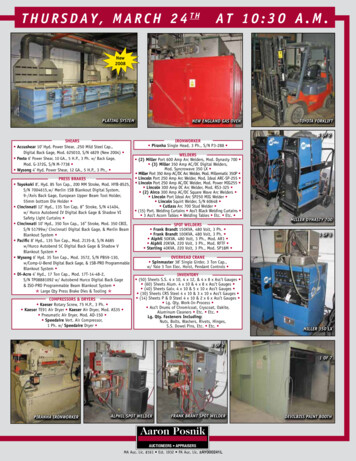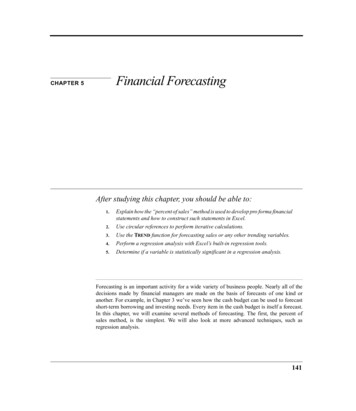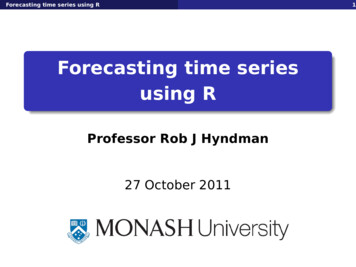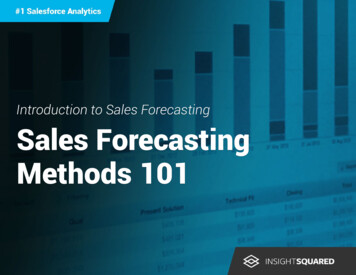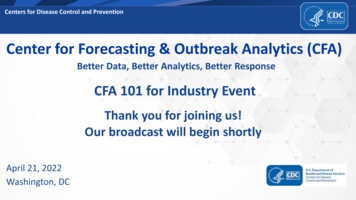
Transcription
Centers for Disease Control and PreventionCenter for Forecasting & Outbreak Analytics (CFA)Better Data, Better Analytics, Better ResponseCFA 101 for Industry EventThank you for joining us!Our broadcast will begin shortlyApril 21, 2022Washington, DC
Centers for Disease Control and PreventionCenter for Forecasting and OutbreakAnalytics (CFA)Opening Remarks – Alison Kelly, CDC/CFAApril 21, 2022Washington, DC
ParticipationParticipationOnline Participation Please email all questions toCFA@CDC.GOVIn-Person Participation Please raise your hand to ask a questionduring the designated Q&A sessions3
Today’s AgendaToday’s AgendaThursday April 21st, 2022Agenda10:00 – 10:15Welcome Address – Alison Kelly, CDC/CFA10:15 – 10:30Introduction to CFA: Purpose, Mission, Vision – Dylan George, CDC/CFA10:30 – 11:00Keynote Speaker – Nirav Shah, Stanford University11:00 – 11:10Predict Division Overview – Marc Lipsitch, CDC/CFA11:10 – 11:20Inform Division Overview – Caitlin Rivers, CDC/CFA11:20 – 11:30Technology & Innovation Division Overview – Rebecca Kahn, CDC/CFA11:30 – 12:00Q&A12:00 – 1:30Lunch on your own1:30 – 1:35Afternoon Session Overview – Alison Kelly, CDC/CFA1:35 – 2:20Industry Panel: Data, Analytics, and Technology Requirements to Transform Health Emergency Response2:20 – 2:55Lightning Talks by Industry Leaders2:55 - 3:00Closing Remarks – Dylan George, CDC/CFA4
Centers for Disease Control and PreventionCenter for Forecasting and OutbreakAnalytics (CFA)Analytics (CFA)Introduction to CFA: Purpose, Mission, Vision – Dylan George, CDC/CFAIntro to CFA: Purpose, Mission, Vision – Dylan GeorgeApril 21, 2022Washington, DC
CFA Leadership & Key PlayersCFA Leadership & Key PlayersDylan GeorgeDirector of OperationsMarc LipsitchDirector of ScienceAlison KellyDeputy DirectorCaitlin RiversAssociate DirectorRebecca KahnSenior ScientistKaren StameyManagement Officer6
Problem StatementProblem StatementData for Action in a Pandemic Disease outbreaks are becoming more frequent and more disruptive. The nation lacks data, analytical systems to identify and respond quickly, effectively. The U.S. must improve these systems and develop capabilities for producing forecasts and analytics that leaderscan use to make timely, informed decisions about how to best prepare for and respond to infectious diseasethreats. Models and analytics need to be responsive to concerns of underserved communities, and address issues ofhealth equity directly.7
What is Forecasting and Outbreak Analyticsand What is the Value?
Example COVID-19 Questions that Modeling Can InformExample COVID-19 Questions that Modeling Can Inform What is the probability of a future surge? What degree of immune escape in a variant would cause a surge? How many tests would be needed to support widespread diagnostic andscreening testing? What role will vaccine availability for young children play in changing theepidemic's trajectory? How would 50% booster coverage change the epidemic's trajectory?9
Proposed CFA Value in the Outbreak of Novel PathogenProposed CFA Value in the Outbreak of Novel PathogenMake sense of uncertaintyearly in an outbreak Assess epidemicpotential and severityQuantify risk andtiming of importedcasesAssess risk to thehomelandProvide early warning,situational awareness Develop good-badworst planningscenarios; bounduncertaintyGet critical data for theresponse Resource demandprojections Inform design andtargeting of prevention Assess expected impact measuresof interventions Monitor vax, treatment Produce short termforecastseffectiveness over time Provide data to updatescenarios and forecastsSupport policy andguidance Inform policy andguidance on: Border controls Testing, quarantine &isolation Countermeasuredemand Vaccine prioritization Surveillance design
CDC Plans for Building the Center forForecasting and Outbreak Analytics
CFA OrganizationCFA OrganizationPREDICT Analytics team – Real-Time Monitoring team, Analytics Response TeamTargeted studiesEngagement, strategic partnershipsINFORM Federal supportSTLT decision supportGeneral public risk communicationINNOVATE Science / contract managementProduct development – applications, enterpriseTest beds – STLT, payer/providerTECHNOLOGY Develop and Refine Technology for the Analytics PlatformBuild ProductsEstablish CFA Data Requirements12
Principles to Guide DecisionsPrinciples to Guide Decisions1Mission ImpactCFA will focus onsaving lives andprotecting peoplethrough outbreakdata, forecasts andanalytics.4Equity FocusedCFA will support efforts toachieve health equity byusing data to identify andtrack health disparities inoutbreaks and informpolicies to address thosedisparities.Open andTransparent2CFA will make data,analyses, and scientificmethods open to thepublic in human andmachine-readable formatsas much as possible.3Collaborative3CFA will work with partners,including in the public sector,private sector, academia, andcivil society to coordinateefforts and maximize impact.13
DevelopingAnalytics& ForecastingFY 2021OutbreakCFA FundedActivities,Cont.Will Take Time, ResourcesAdvancing Weather Forecasting:Took Time, Data, Models, and Resources to DevelopIncreases in numerical weather forecasting skill through time Forecasting Skill TimeDeveloping Outbreak Analytics & Forecasting Will Take Time, ResourcesAdvancing weather forecastingcapabilities took decadesNeeded ingredients:o Datao Modelso Peopleo Computational Powero Specific Use Caseso Sustained FundingDiseases forecasting, analytics still inearly stages14
Centers for Disease Control and PreventionCenter for Forecasting and OutbreakAnalyticsAnalytics (CFA)Keynote Speaker: Nirav Shah, Stanford UniversityKeynote Speaker: Nirav Shah, Stanford UniversityApril 21, 2022Washington, DC
Accelerators of Actionable DataCenter for Forecasting and Outbreak AnalyticsIndustry Day – April 21, 2022Great Hall, Washington, DCNirav R. Shah, MD, MPHSenior Scholar, Stanford UniversityChief Medical Officer, olea.health
Disclosures Senior Scholar at Stanford UniversityChief Medical Officer of olea.healthBoard Member at STERIS plc, CovidActNow.org, KinsaAdvisor to GSR Ventures Advisory Committee to the Director of the CDCCommissioner, Commonwealth Fund Commission on a National Public HealthSystemSenior Fellow of the Institute for Healthcare Improvement (IHI)Trustee of the John A. Hartford FoundationPrior Board Chair, Linux Foundation Public HealthPrior service as Commissioner, NY State Department of Health, andChief Operating Officer, Kaiser Permanente in Southern California All views expressed are my own
What metrics to follow?Hospital workers out with COVID New infectionsER visits (A/D/T feeds)HospitalizationsBeds available in ICUsMortalityAND Hospital workers out with COVIDWastewater surveillanceDaily average fever countsNew data sourcesWastewater surveillance
Graph title: Daily average share of population with a fever
Interactive graphic: New cases of COVID per 100k people over time
Sharecare Community Well-Being Index Score for Michigan
Digital Health Companies:Addiction treatment / opioid use disorderDigital health’s investments of 37.9 billion in 2021 793M invested in Substance Use Disorder startups
RECovERIn RECovER, researchers can performqueries across all institutions participatingin the consortium, without anycompromises on privacy or security.Data remains local and private withineach participating institution—no recordsever leave each institution. Softwaremodules from Onai run at each institutionand jointly construct a single aggregatestatistical result, without exposing anyinstitution's local results to any otherinstitution. This mechanism enablesgreater security and speed thantraditional approaches.
Lessons Learned & Next Actions Measurement needs and reporting needs change in real timeCommunicate about data in ways that the public can receive & understand itThere’s more than enough data, we have to look for it and accept it from theprivate sector and othersTechnology can already address many privacy and security concernsWhat you can do Standardization is Innovation, e.g. for interoperability Embrace private and nontraditional data Support people doing great work: Kenneth Mandl, Rick Hawes, AneeshChopra, Bala Hota, many others on the stage today, and of course Dylan, Marc,Rebecca, and Caitlin
Centers for Disease Control and PreventionCenter for Forecasting and OutbreakAnalytics (CFA)Analytics (CFA)CFA 201 – Breakdown by DivisionCFA 201 – Breakdown by DivisionApril 21, 2022Washington, DC
Centers for Disease Control and PreventionPredict Division OverviewPredict Division OverviewMarc Lipsitch, DPhilDirector for ScienceCenter for Forecasting and OutbreakAnalytics
Predict: The Engine for Better Data and Better AnalyticsPredict: The Engine for Better Data and Better AnalyticsGOALSPREDICT Generate forecasts and analyses to supportoutbreak preparedness and response efforts Support critical data collection efforts to addressresponse priorities Respond to needs of Federal, State, Tribal,Territorial and local leaders for analytical,forecasting results27
Analytics Inform Response Efforts Across an EpidemicAnalytics Inform Response Efforts Across an EpidemicExamples of Outbreak AnalyticsProspective ScenarioAnalysesRisk Assessment ToolsPhylogeneticsPathogenCharacterizationGraphic courtesy of bnext/iqtParameter EstimationsOutbreak ManagementScenario AnalysesDisease ForecastingDisease Risk MappingVaccine EffectivenessBurden, ImpactAssessmentsDraft / Pre-DecisionalTherapeuticEffectiveness28
Planned Analytic ProductsPlanned Analytic ProductsReal-Time Monitoring (Routine, Periodic) Forecasting, Nowcasting Scenario Analysis Natural History / Parameter EstimationTopical Analytics (As Needed per Response Priorities) Health Equity and Vulnerable PopulationsCommunity MitigationVaccinesTherapeuticsTesting and DiagnosticsPathogen VariantsMobility and BordersSetting-specific Transmission29
Planned Critical Data Collection ActivitiesPlanned Critical Data Collection ActivitiesTargeted Studies toAnswer Key Questions Transmissibility Viral Kinetics Severity Immune escape Vaccine escape DiagnosticsensitivityRandom Sample ofthe Population forVirologic Testing Possible models: UK’sReal-time Assessment ofCommunity Transmission(REACT) and Office forNational Statistics (ONS)studies Continuoussampling with multiplexassays and sequencing ofpositivesPotential PartnersInclude but notLimited to: Payer-providernetworks/managedcare Nursing homes Academia Industry30
Work to Date & Early Successes
Early Evaluation of Omicron SurgeEarly Evaluation of Omicron SurgeScenarios developed in November/early December 2021 asSouth African surge was under wayInherenttransmissibilityrelative to DeltaImmune escaperelative to all priorstrainsFaster growth(Highertransmission**.Mid escape)1.6x43%Slower growth(Highertransmission. Lowescape)1.5x10%Faster growth(Unchangedtransmission. Highescape)1.0x85%Slower growth(Lowertransmission. Midescape)0.8x50%Scenario **Parameters were chosen to span a range of apparent growth rate advantage for Omicron over Delta of 2-3.5x in an environment where 75% of the population has immunity to infection due to vaccination orprior infection.**Relative to Delta
Omicron SeverityOmicron SeverityAssessed Omicron severity relative to Delta using datafrom Kaiser Permanente Southern California52% reduction in hospitalizationFor latest 22.01.11.22269045v274% reduction in ICU admission
COVID-19 Response SupportCFA’s COVID-19 Response Support CFA, in collaboration with teams in academia and experts in the office ofthe Assistant Secretary for Preparedness and Response, have contributedanalyses related to:School test-to-stay guidanceTravel policyNursing home guidanceVaccine guidance34
Centers for Disease Control and PreventionInform Division OverviewInform Division OverviewCaitlin Rivers, PhDAssociate DirectorCenter for Forecasting and OutbreakAnalytics
Inform: Customer-Driven Risk CommunicationsInform: Customer-Driven Risk CommunicationsGOALS Communicate with expert disease modelers,emergency responders to meet the needs ofdecision-makersINFORM Share timely, actionable information with theFederal government; STLT leaders, and the public Coordinate early warning efforts between CDCsubject matter experts and USG interagency36
Objectives & StakeholdersObjectives & Stakeholders Objectives Inform stakeholders of the modeling results and analyses producedin the Predict Division Learn and relay stakeholders’ questions and priorities to the Predictand Innovate Divisions Raise awareness and support for the role of modeling and analyticsin outbreak preparedness and response Ensure communications are fast, effective, and oriented for decisionmaking37
Inform Staff – ResponsibilitiesInform Staff - Responsibilities Responsibilities to Include: Maintain an informal network of academic modelers (andparticipate in existing networks, e.g., Models of Infectious DiseaseAgent Study (MIDAS)) to advance R&D priorities and establishreserve capacity for times of pandemic. Participate in STLT task force in Incident Management structure Coordinate with the Federal Emergency Management Agency andthe Department of Health and Human Services regionalcoordinators and associated data analysts38
Inform StaffInform Staff ListingVisualizationExpertsInteragencyLiaisonsCDC LiaisonsPublicLiaisonsState andLocal Liaisons39
Work to Date & Early Successes
State, Tribal, Local, and Territorial (STLT) Focus GroupsState, Tribal, Local, and Territorial (STLT) Focus Groups Sharing examples of products and tools CFA could provide and solicitingfeedback on if they are useful Notification of Significant Findings Omicron Severity Analysis Outbreak analytic tools (nowcasting, Rt, descriptive analyses) Collecting feedback from State and Local Public Health partners Feedback will help shape CFA's work, for example the test bed pilot41
Requirements for Success
Information Management and ProcessInformation Management and ProcessInformation Management Data set responsibilities within CFA Data use agreements with key partners - other CDC programs, Federaldepartments and agencies, STLT partners, private sector Processes to manage requests for information Approaches for managing variations on products, e.g., one set of analyticalresults with communication materials tailored to different audiences43
Information Management and Process contd.Information Management and Process continuedProcess Tools for communicating andvisualizing modeling andanalytical results Approaches for visualizinguncertainty44
Centers for Disease Control and PreventionInnovation & Technology Division OverviewInnovation & Technology Division OverviewRebecca Kahn, PhDSenior ScientistCenter for Forecasting and OutbreakAnalytics
Innovation: Driver of the CFA Future StateInnovation: Driver of the CFA Future StateGOALSINNOVATE Support research and development to improveoutbreak forecasts and analyses Collaborate with and support academic, privatesector, and interagency partners Create translational tools, products, enterpriseenhancements to make analyses of pandemic dataflexible, fast, and scalable for STLT authorities46
Support Research and Development toImprove Outbreak Forecasts and Analyses
Initial WorkInitial Work Funded academic partners (Harvard, Utah, Johns Hopkins) to: Improve forecasting and outbreak analytics for emergency decision-making Use modeling to inform public health actions with emphasis on equity Expand and upskill the public health workforce Established partnership with National Science Foundation (NSF) to Sustain the ability to rapidly fund academic groups to address emergingpriorities (modeling and non-modeling) during any response Established partnership with Department of Energy (DOE) to Bring DOE’s advanced computing capabilities in high performance computinghardware, software, algorithms and expertise to bear on epidemiological modeling Develop novel algorithms and new software to meet CDC requirements48
Create Translational Tools, Products, andEnterprise Enhancements to Make Analysesof Data Flexible, Fast, and Scalable
Test Bed: Innovating Analytical Capabilities & Developing PartnershipsTest Bed: Innovating Analytical Capabilities & Developing Partnerships Develop innovative, analytical capabilities and partnerships withstate/local public health agencies, healthcare organizations, privatesector, and academia Establish a multidisciplinary community of practice to evaluate,share, and scale successes and innovations50
Test Bed ObjectivesTest Bed Objectives Integrate novel data sources or technology into outbreak analytic tools or pipelines.Examples include: Integrate wastewater, genomic, or mobility data into forecasts or analyses Develop novel survey approaches, particularly behavior related Create, enhance, or integrate analytical tools for outbreak response at federal andlocal levels. Examples include: Tools for nowcasting (i.e. adjusting for reporting delays), geographic targeting of interventions, orstrategies for implementing interventions Develop and enhance visualization, communication of results to decision makers Enhance ability to quickly respond to outbreaks and inform decisions51
Technology: Architecture Upon Which CFA is BuiltTechnology: Architecture Upon Which CFA is BuiltGOALSTechnology Develop and Refine Technology for theAnalytics Platform Build Products Establish CFA Data Requirements52
Analytics / Decision-Support PlatformAnalytics/Decision-Support Platform Develop CFA technology architecture, critical workflows Cloud-first approach Enable surge capacity – preparation, onboarding, access control foradditional analysts, and technologists in an emergency situation Develop and maintain back-up, “on-premise” analytical platforms Develop and refine visualization, communication, and decision-supportcapabilities53
Building Products – Tooling and Enterprise CapabilitiesBuilding Products – Tooling and Enterprise Capabilities Develop analytical tools and products for CFA and CDCenterprise systems Transition successful innovations to operations Create flexible analyst tools to support rapid response needs Improve and automate mission critical workflows54
Analytics Platform – Early Products
Initial Analytics Workflows & ProductsInitial Analytics Workflows & ProductsForecasting & Scenario Models Internal modeling capability (enterprise level software) External contributions Ensemble processQuestion X – Support for the Analytics Response Team Refine general data science and analytics tools Develop rapid response tools Establish an efficient, flexible and collaborative data science platform56
High Level Technology Requirements
Technology Requirements & ComponentsTechnology Requirements & ComponentsData Lake / Data Warehouse Secure data repositoryData Tools Unified data foundation: ingest, store, shareMetadata Management Data provenance, version controlAccess Cloud environment, on-prem capabilities, web hosting, public access58
Technology Requirements & Components contd.Technology Requirements & Components continuedPredictive Analytics / Advanced Data Tools Customizable models, code repository, scalable computeBusiness Intelligence Tools “No-code” solution for retrieving, analyzing, transforming, and reportingdataDecision Support Dashboards, reports, bespoke analytics, publishing tools59
Q&AQuestions & AnswersQuestions?Online participants:Email questions toCFA@CDC.GOV60
Center for Forecasting & Outbreak Analytics (CFA)Lunch BreakCFA 101 for Industry EventWe are on lunchbreak – please planto return by 1:30PM EST61
Afternoon Session OverviewAfternoon Session Overview Agenda Items Industry Panel (45 min) Lightning Talks fromIndustry Leaders (35 min) Closing Remarks (5 min)62
Industry Panel: Data, Analytics, and Technology Requirementsto Transform Health Emergency ResponseIndustry Panel: Data, Analytics, and Tech Requirements to Transform Health Emergency ResponsePanelists:Michelle Holko – GoogleEthan Berke – United HealthCaitlin Rivers – CDC/CFAModerator:Dylan George, CDC/CFA63
Lightning Talks from Industry LeadersLightning Talks from Industry LeadersDatabricksPeratonMicrosoftRTIDell TechnologiesRed Hat/CarahsoftOptum ServeMaximus Public Health AnalyticsModerator:Alison Kelly, CDC/CFA64
Closing RemarksClosing RemarksPlease visit us at www.cdc.gov/cfaFor any outstanding questions, comments, orto stay in touch, please email CFA@CDC.GOV65
Apr 21, 2022



